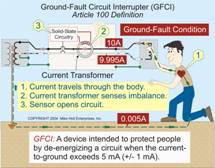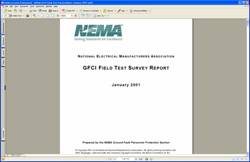Why are we seeing so many GFCI receptacle failures?
By: Scott A. Hightower
 I am an electrical engineer (University of Kentucky BSEE 1979) with about five years of experience working as an electrician. I work closely with a Master Electrician with nearly 40 years of experience as an electrician and electrical contractor, another Master Electrician with approximately 30 years of experience and another electrician with approximately 20 years of experience.
I am an electrical engineer (University of Kentucky BSEE 1979) with about five years of experience working as an electrician. I work closely with a Master Electrician with nearly 40 years of experience as an electrician and electrical contractor, another Master Electrician with approximately 30 years of experience and another electrician with approximately 20 years of experience.
Background: We install mostly 15A, 125V GFCI receptacles in residential and some light commercial settings, with about an equal mixture of new construction and remodeling of existing structures.
We have noticed what appears to be an increased failure rate for installed GFCI receptacles over the last several years. We have not kept records of failures; therefore this problem description is mostly anecdotal.
The electrical contractor believes that he began seeing a noticeable increase in failures roughly five years ago. Many of the failures are discovered by homeowners within our one year warranty. In some cases we have replaced GFCI receptacles as many as three times within that first year. It is not unusual for us to replace at least one before final inspection of the job.
In some cases, we suspect damage due to surges (recent thunderstorms before the failure is discovered) or moisture (outdoor locations).
However, this does not account for most of the failures.
Definition of failure: I count a failure only where the GFCI receptacle does not operate correctly after confirming that it has been properly wired. Sometimes, of course, we find installation problems (e.g. line and load reversal or ground wire contact with load neutral), but I don't consider these to be failures so long as the GFCI receptacle operates correctly after fixing the installation problem.
Failures we have seen include the following: Cannot reset after tripping (most common), cannot trip with test button, cannot trip with other test, no voltage across hot and neutral outlets after reset, and voltage across hot and neutral outlets after tripping (one uncertain instance).
Testing GFCI receptacles: The inspectors use a pluggable test device that indicates presence of voltage, reversal of hot and neutral or missing ground or neutral. GFCI operation is tested with a button on this device.
Most of us use a similar device most of the time. The electrical contractor has always used a 60W incandescent bulb in a drop socket to test receptacles, and tests GFCI operation by attaching it to the hot outlet and ground. The rest of us will test the same way if our receptacle tester is not readily at hand.
Recent extreme example: We have just finished a new church building (light commercial, all wiring in conduit--mostly MC, some PVC and EMT). At project completion, there were 9 GFCI receptacles installed in 5 restrooms, a break area and outdoors. We have performed 7 replacements due to failure. In one location, the GFCI receptacle was replaced twice. (In another location, the GFCI receptacle was also replaced twice, due to an "out of the box" failure--the first replacement never worked correctly.) The single outdoor GFCI receptacle was installed just before final inspection, so it hasn't had time to fail.
The indoor GFCI receptacles are distributed between three branch circuits, two fed from a remote subpanel and the other (break area) fed from a subpanel close to the main distribution panel. All three branch circuits are wired in MC. GFCI receptacles have failed on all three branch circuits.
The break area branch circuit has two GFCI receptacles with no load side attachments and two unprotected receptacles outside the sink area. The first GFCI receptacle has been replaced once (twice if we count the "out of box" failure.)
The upstairs restroom branch circuit has four GFCI receptacles, one protected receptacle attached to the third GFCI receptacle and no unprotected receptacles. The first and last receptacles have each been replaced once. This branch circuit was initially wired improperly: The second GFCI receptacle fed a protected receptacle, which was then connected to the third GFCI receptacle and its attached protected receptacle. In addition, the second GFCI receptacle had reversed line and load attachments. The reversal was eliminated by changing to a line-side connection only and another GFCI receptacle replaced its attached protected receptacle. The last GFCI receptacle was discovered to have failed when the improper wiring was corrected.
The downstairs restroom branch circuit has two GFCI receptacles, with a protected receptacle attached to the second, one unprotected receptacle split off ahead of the first and one unprotected receptacle between the first and second GFCI receptacles. This branch circuit has been in operation longer than the others. The first GFCI receptacle has been replaced twice and the second has been replaced once.
Experience of others: From time to time we have asked other electricians if they have seen similar failure rates and have asked at the supply stores if they are seeing a lot of returns due to failed GFCI receptacles. Until recently, the answer has always been "No." This has made us wonder if we are doing something to cause the high rate of failures, or if other electricians are unaware that they can return the failed GFCI receptacles.
Recently I asked again at the supply house and they said yes, they were suddenly seeing a lot of returns.
Thoughts on possible causes: We test frequently and thoroughly, especially just before final inspection. We are now wondering if the 60W incandescent bulb load between hot and ground could cause some failures.
It is not unusual for construction equipment (saws, air compressors, drills, etc.) to be plugged into whatever receptacles we happen to have powered up. I'm wondering if this might expose the GFCI receptacles to an unusually high amount of electrical "noise."
Scott A. Hightower
NEMA GROUND FAULT PERSONNEL PROTECTION (GFCI) SECTION ACTION

In 1999, members of the NEMA GFCI Section received reports of non-operational Ground Fault Circuit Interrupters (GFCI) whereby, afterthe GFCI had been installed, the GFCI could not perform its intended function or later became non-operational. In response to these reports, the members of the NEMAGFCI Section, at its meeting on September 8, 1999, passed a resolution that read:
“NEMA 5PP Section supports the conduct of an impartial and comprehensive investigation of field performance of GFCIs. The investigation objective is to obtain statistically valid data to identify, define, and quantify long term operation of GFCIs in the installed infrastructure. For suspected field failures, both the installation and the product must be analyzed and data compiled to enable clear definition of the cause of failure (including condition of use andenvironment) and mode failure (e.g., SCR failure, test button failure) sufficient to define remedial action(s) if required”
The GFCI Section formed the Field Test Survey Task Force at that meeting to define the study and how it would be conducted. The study examined 2,680 GFCIs installed in 1,090 residences in ten locations within the United States. The task force completed the study and this is the report of the findings. The task force has not attempted to draw conclusions on the results of the study but rather to report the results of the findings.
Click here to review the GFCI Field Test Survey Report.